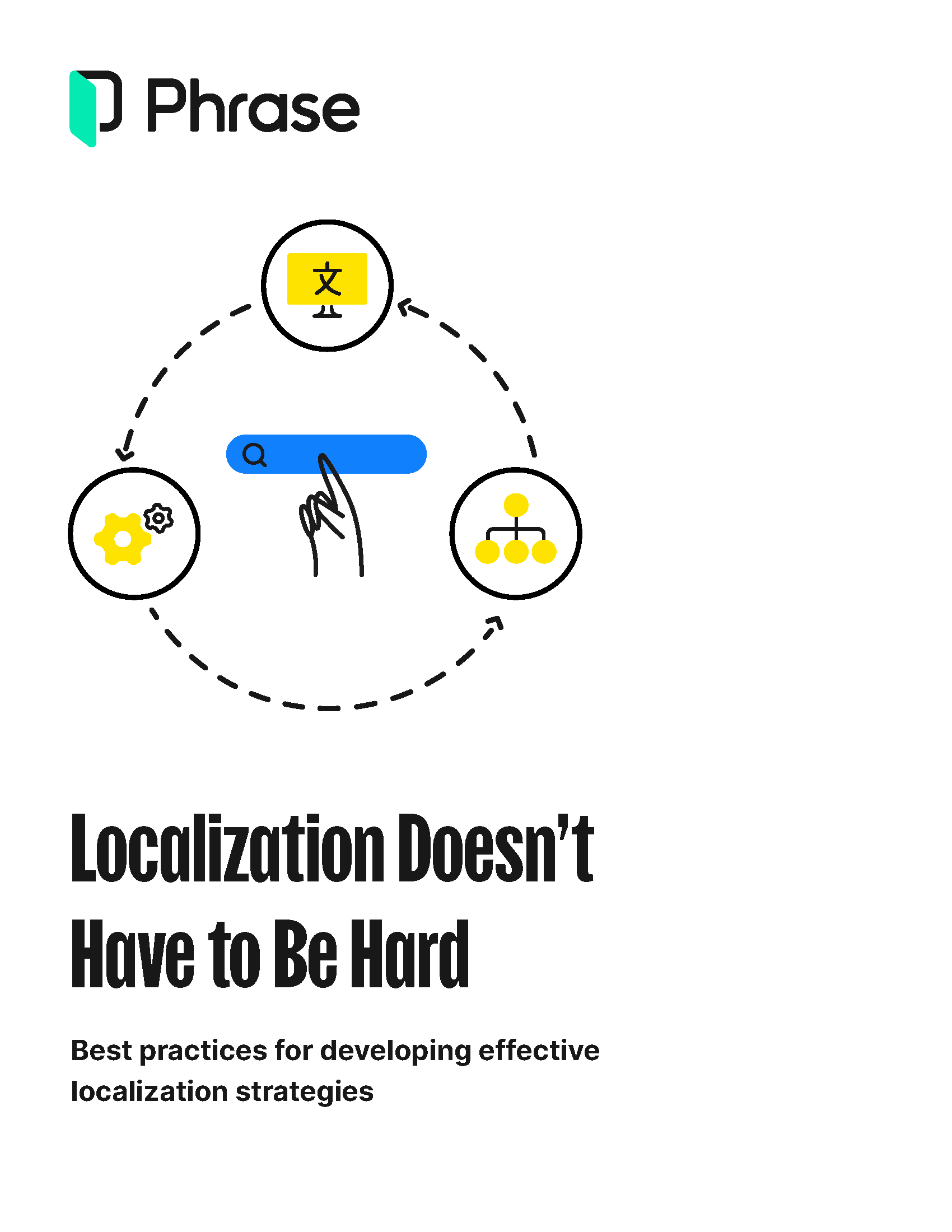Localization strategy
Localization vs Translation: The Difference Explained

The likely most fundamental challenge to global expansion is breaking down the language barrier. In response to it, more and more companies are hastily putting translation and localization at the top of their agendas. However, shortly after setting out on their global journey, most of them end up realizing that both processes, although similar, aren’t one and the same.
As much as translation matters, rolling out a global product isn’t only about transferring an application, website, or marketing assets from one language to another. Instead, making a product accessible to people across cultures means adapting it to cultural differences, linguistic specificities, purchasing habits, legal requirements, and more.
To be more specific:
- Translation renders a message from one language into another.
- Localization adapts a translated message to the local context of the recipient.
This one big difference makes translation a key part of localization. Both processes are mutually reinforcing and linked under the umbrella of globalization.
Failing to realize and appreciate the difference behind the pair of localization vs translation can have serious consequences for anyone looking to expand the global footprint of their business. To help you get a better understanding of it, this guide will walk you through the ins and outs of both translation and localization.
Translation and localization: What’s the difference?
As we’ve briefly touched on above, the main difference between translation and localization is that translation only covers language transfer while localization also involves adapting everything from content and visuals to user experience and layout to a specific market.
Here are some examples of what you need to take into account during localization to make your product work for users in their local context.
Slang, idioms, colloquialisms
Slang words carry much more than just the concepts they describe. They often reveal a lot about the speaker’s social background, age, and even mood. Simply replacing them with their dictionary equivalents might not only sound unnatural but also fail to deliver the message as intended.
Imagine a brand whose entire messaging is based around American youth slang. Directly translating funny little words such as “on fleek” or “lit” into other languages would be a surefire way to lose the company’s target audience in other markets. Instead, you need to carefully research the local equivalents of such words and expressions to make sure your message still hits home.
Slogans
Slogans are another great example of how localization can go beyond translation. A slogan that works in one market might not only sound odd but also be completely meaningless in another. This is because slogans often rely on wordplay, puns, or other linguistic specificities that don’t translate well (or at all).
Take “I’m loving it.” The non-standard grammar of this iconic McDonald’s slogan would be completely lost in languages where “present continuous” is not a thing. If it meant and sounded just the same as “I love it,” it would be nowhere near as effective.
Symbols, icons, and colors
Colors are often loaded with cultural meanings that don’t necessarily translate well to other cultures. For example, white is the color of purity in Western cultures but death and mourning in Eastern ones.
The same goes for symbols and icons: The common Western sign for “okay” (👌)has a vulgar meaning in Arabic cultures. An even more amazing example, the “slightly smiling” emoji (🙂) is actually a sign of disbelief in China.
Imagery
Images are another highly culturally influenced element. A picture that works in one market might not only look odd but also be completely meaningless in another. This is because images often rely on cultural specificities that don’t translate well (or at all).
For example, the picture of a Christmas tree on a Christmas card would be lost in cultures where Christmas is not a thing. Depending on the context, it might even be seen as offensive.
Text length and direction
Localization also involves technical aspects that go beyond translation. For example, text length and direction are two things that need consideration when localizing a website or an application.
Some languages, such as German, are much longer than English. So if your designer’s approach is to cram as much text as possible into every nook and cranny of the UI, you might end up with too little space for the translated text.
The same goes for text direction: Right-to-left languages such as Arabic or Hebrew need to be taken into account when designing the UI. This means, first of all, that you should internationalize libraries, fonts, and tools that support them.
Currency, number, date, and time formats
Another technical aspect of localization that goes beyond translation is currency, number, date, and time formats.
Different countries use different currencies, so you need to make sure your product or service can handle them all. The same goes for date formats: In the US, people write dates in M/DD/YYYY format—e.g. 3/14/2015—while in most other countries, DD/MM/YYYY is the norm—e.g. 14/03/2015.
The list goes on for time formats and even phone numbers, so if you’re planning to expand your business globally, make sure your product is able to handle all the different formats.
Legal requirements
Last but not least, there are also legal requirements that can differ from one market to another and which you need to consider during localization. For example, different countries have different laws and regulations regarding terms and conditions, privacy policies, cookies, and so on.
In the European Union, for example, the General Data Protection Regulation (GDPR) requires companies to get explicit consent from users before collecting, using, or sharing their personal data. This means that if you’re planning to expand your business to the EU, you need to make sure your product or service complies with GDPR.
Translation vs localization: Which should I choose?
So, with the difference between translation and localization explained, you might be wondering: Which one should I choose?
The answer is: It depends on your needs. If you’re looking to simply transfer the meaning of your content from one language to another, then translation is probably all you need. If you want to adapt your content to a specific market, then localization is the way to go.
When you might be better off with good old translation
Here are some examples of text types where translation is normally enough:
- User manuals
- Medical documents
- Technical specifications
- Training manuals
- Scientific journals
In general, any content that includes universally valid information and that doesn’t require any cultural adaptation will do just fine with “just” translation. Don’t take this assertion as playing down the importance of translation—translation is one of the most challenging professions out there.
When you might need localization
Here are some examples of content and other types of assets where localization is often necessary:
- Web or mobile apps
- Marketing websites or campaigns (e.g. ads, social media posts)
- Brand names and slogans
- Packaging and labels
In general, for any content that is at least slightly related to marketing your product or service in another cultural context and in a foreign language, localization is the way to go.
Having said that, it’s worth pointing out that managing a localization project isn’ just a side task for your marketing team. It’s a complex process that requires careful planning, coordination, execution, and, in most cases, a dedicated, full-time localization manager.

Free download
Best practices for developing effective localization strategies
Explore how to tackle localization management efficiently and engage customers across the globe in their native languages and local experiences.
How does localization work?
We could—and actually did—write an entire article on how localization works. Still, for the sake of brevity, we’ll just give you a quick overview here, depending on the kind of localization you’re after:
Software localization
Software localization is the process of adapting a software application to a specific market. This includes adapting the UI, splash screens, in-app tooltips, and all user-facing content, such as error messages or help documentation, to the target market—all while making sure that the software still functions as intended.
Website localization
Your website is often the first point of contact for potential customers in a foreign market. This is why it’s essential to make sure that they go past your homepage and stay on your site long enough to learn more about your product or service. Website localization helps you do just that by adapting your website’s content, design, and user experience to the specific needs of your target market.
Game localization
Few audiences are as demanding as gamers, and few things are as hard to localize as video games. Slang, humor, succinct cultural references—all of these make game localization a pinnacle of the craft.
Although the process here is similar to the one you’ll have for software localization, it makes sense to add “damage control” steps such as beta testing with a select group of gamers or setting up a local community management team to handle feedback and complaints.
Marketing localization
Marketing localization stands apart from the other types of localization because it’s not really about translating content. It’s about adapting your whole marketing strategy to a specific market, and that means understanding the local culture, customs, and trends.
In some cases, marketing localization will require copywriting to create new content from scratch or a deep rework of your existing material in a process known as transcreation. This makes it the only example of localization where translation might not be involved at all.
Whatever scenario best describes your needs, the most effective way to manage both translation and localization for global expansion is to use cloud-based translation software. A translation management system, for example, eliminates manual and repetitive translation tasks through smart automation and can fully manage the flow of multilingual content from submission to publishing.
Complementing, not competing
Localization and translation are two different things, but they’re not mutually exclusive. In fact, localization is impossible without translation, while the best translations entail at least some adapting of the content to the target audience.
In other words, localization and translation are 2 complementary processes that work together to help you reach your global audience. From adapting your marketing strategy to local trends to translating pages and pages of user documentation, both localization and translation are essential to your global success, and the latter is a key part of the former.
Speak with an expert
Want to learn how our solutions can help you unlock global opportunity? We’d be happy to show you around the Phrase Localization Suite and answer any questions you may have.
Last updated on March 10, 2023.




